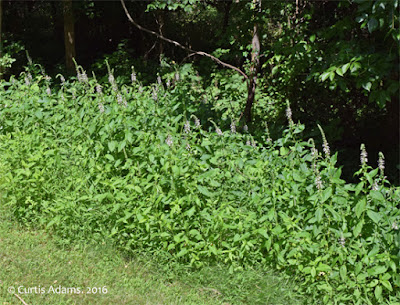 |
| Here's some orange conflower poking through a mass of vines, including virgin's bower, Clematis virginiana, and passion vine, Passiflora incarnata (the large palmate leaves at the top). |
While the black-eyed Susans (Rudbeckia hirta) have been blooming since June its not until mid-summer that other members of the genus Rudbeckia kick into high gear. Most folks are familiar with orange coneflower, R fulgida, particularly some of the cultivars like 'Goldstrum' and 'Viette's Little Suzy'. But there are other species in the genus that are worthy additions to the home landscape.
 |
| These cutleaf conflowers are 5-6' tall and blooming in open shade. |
 |
| Unlike many other Rudbeckias cutleaf coneflower has a green central cone. |
 |
| These plants are growing on the edge of my vegetable garden, a perfect disturbed habitat. I will be pulling seedling out next year. |
Another species of coneflower that is performing well this year is brown-eyed Susan, R. triloba. This species has smaller, more rounded flowers than either orange coneflower or black-eyed Susans. However, it does grow larger, 1.5-4.5', than those two. The Latin name 'triloba' refers to the 3-lobed leaves that tend to occur near the base of the plant (none of these are visible in this photo.)
This is a short-lived perennial that prefers average to dry soils and part to full sunshine. It is usually found in disturbed habitats, on the edges of fields and paths. It tends to get shaded out by longer lived perennials in less disturbed habitats. The deer really ate this species up at first, now they browse on it occasionally. Still, I need to protect mine in order to get a full set of blooms.
Note: all four of these species of Rudbeckia are native to the Chesapeake Bay watershed.







